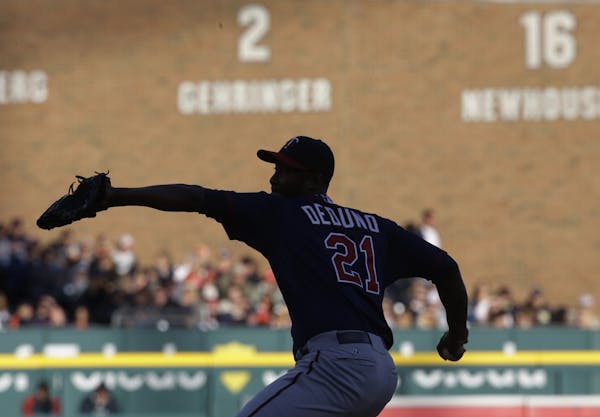TWINS INSIDER La VELLE E. NEAL III
Seattle's Kendrys Morales hit ball to the right-center field wall Sunday at Target Field, and it sure looked like a double.
Morales hurried around first base and headed for second — which turned out to be a mistake.
Twins right fielder Chris Parmelee ran down the ball, with Aaron Hicks not far behind, encouraging him.
"I was like. 'Hey! Throw this guy out!' " Hicks said.
Parmelee turned and fired to Pedro Florimon, who was waiting for throw at second and tagged Morales out.
Another one bites the dust.
"I liked that play a lot," Hicks said. "Especially since I kind of called it."
Hicks has showed off plenty of range and a powerful arm. He is tied for second in the majors with six assists. But Parmelee is right behind with five. And neither has been charged with an error. It's an odd couple, the speedy switch-hitting Hicks and the broad-shouldered, lefty-hitting Parmelee, but baserunners beware, the pair will be on point during relays and cutoffs. And advance bases at your own risk.
"I think, for the most part, we're making the plays," Twins manager Ron Gardenhire said of his defense. "We get the ball to the right guys on the cutoff. We're hitting the relays."
Hicks made the jump from Class AA New Britain with his defense being the least of the Twins' concerns. His range is obvious and his arm is strong — while pitching in high school he once hit 97 miles per hour on the radar gun.
And he's fearless. He has stolen home runs away Chicago's Adam Dunn and Milwaukee's Carlos Gomez, crashing to the ground after making the catch.
"To help my pitcher out, to help prevent a run, I'll do that all day," Hicks said.
Parmelee was a center fielder in high school when the Twins first scouted him, and he has played in 286 minor league games as an outfielder. But he's not fast — Twins General Manager Terry Ryan said he doesn't run as well as former Twins outfielders Michael Cuddyer or Jason Kubel — and is better suited to play first base.
But Parmelee has worked to get the best jumps possible. He has learned to play the right-field wall, which isn't easy at Target Field. The bottom part of the wall is padded, the area above the padded part is marine-grade plywood and there's the limestone on the facing of the overhang. An outfielder has to learn how the ball caroms off all three surfaces.
And Parmelee's throws have Cuddyer-like accuracy.
"We get out there almost every single day during batting practice and make some throws," Parmelee said. "You throw at 80 to 90 percent [of maximum effort] just to see how the grass skips when you make the throws. You know the trajectory and how hard you need to throw it, and what angle you need to take to get the ball there on a nice hop."
Parmelee has been a pleasant surprise in how efficient he has been in right field. Opponents will start to think twice about stretching singles into doubles on Parmelee's arm, a big advantage because holding a runner to first keeps the double play in play.
"Everyone has been concerned about his defense," Ryan said. "His defense has been quite good and we're not talking about zone range or UZR [his ultimate zone rating, -1.2]. He's making plays. He doesn't have great range, we all know that. We'll acknowledge that the guy makes plays and gets to balls he should get to and finishes them.
"Most importantly, his throws are accurate he doesn't miss cutoff guys that much."
Josh Willingham, the left fielder, is not part of this conversation. He's here to mash.
Hicks and Parmelee might develop into offensive threats, but it looks as if they have the defensive thing figured out.
And if you're wondering what the Twins single-season record is for outfield assists is, it's 24, set by Gary Ward in 1983. Can Hicks or Parmelee catch Ward? It depends on how lucky opponents are feeling.
La Velle E. Neal III • lneal@startribune.com

Lacrosse 2024: Boys or girls, discussion begins in the same place

Penn State's starting goalie transfers to Gophers men's hockey

Will 'shotgun only' zone for deer in southern Minnesota be abolished?
NFL draft has potential to set a record for most players on offense selected in the first round

